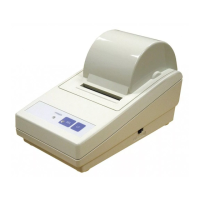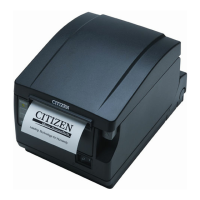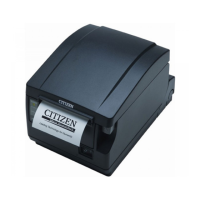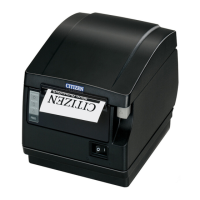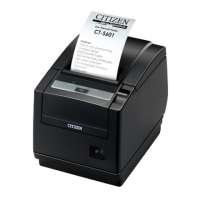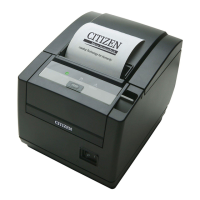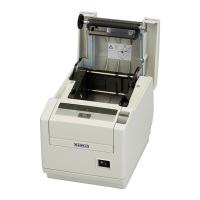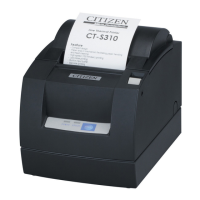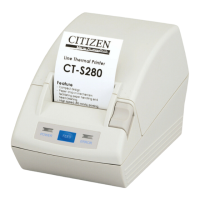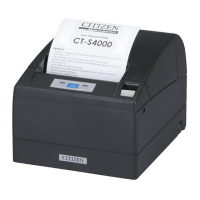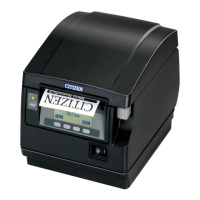Do you have a question about the Citizen CT-S651 Type II and is the answer not in the manual?
Description of WEEE directive for product disposal in the EU, emphasizing separate collection systems for electronics.
Lists standards the printer conforms to, including EMC, Low Voltage, RoHS, and WEEE directives.
Important notices regarding radio frequency energy, potential interference, and specific operational advice for commercial environments.
Guidelines for reading, storing, and using the manual; disclaimers on responsibility for operation, errors, and data loss.
Explains the meaning of warning, caution, and information symbols used in the manual for safe operation and to prevent injury.
Advises against specific installation environments like dusty or corrosive areas and improper handling to prevent failure or electric shock.
Details safety measures for power cord connection, usage, and storage to prevent hazards like overheating, fire, or electric shock.
Cautionary notes on touching hot print heads, sharp edges, and moving parts during operation or maintenance to prevent injury.
Guidelines for routine cleaning and care of the printer, including specific warnings about thermal head temperature.
Lists key features like high-speed printing, compact design, waterproof construction, and supported interfaces.
Lists all items included in the printer package for unpacking and verification.
Explains the system used to classify printer models based on their features and specifications.
Provides a comprehensive table of technical specifications including print width, speed, density, interfaces, and power consumption.
Details the external parts of the printer, including covers, buttons, and rear connectors, with accompanying diagrams.
Describes components found inside the paper cover, such as the platen, paper sensors, cutters, and print head.
Explains functions like buzzer, user memory, memory switches, USB power options, and paper saving features.
Step-by-step guide and safety precautions for connecting the printer's power cord to the AC inlet.
Instructions and diagrams for connecting various interface cables like Serial, Parallel, USB, Ethernet, and Bluetooth.
Explains the Bluetooth status LED and the process for detecting and pairing devices for data communication.
Describes panel button operations for printing network setup information and returning the board to factory settings.
Explains the meaning of the green, yellow, and red LEDs on the Ethernet board for status indication.
Instructions on how to access and modify network settings using a web browser via the printer's IP address.
Details connecting the USB Wi-Fi dongle and operating the board using its panel button for setup.
Explains the LED indicators for wired and wireless LAN connection status, transmission speed, and errors.
Guide to accessing the printer's Web Manager interface using a web browser for status and configuration.
Instructions for logging into the CONFIG screen with administrator credentials to manage wireless LAN board settings.
Instructions and diagrams for connecting a cash drawer, including grounding and important cautions regarding signals.
Specifies that the printer must be positioned horizontally and warns against unstable or dirty locations to prevent damage.
Instructions on how to adjust the internal partition mechanism to accommodate different paper roll widths.
Explains how to set the DIP switches on the serial interface board for communication parameters like baud rate and parity.
Details how to adjust the paper near-end sensor's position to accurately detect when a paper roll is running low.
Step-by-step guide for correctly loading a paper roll into the printer, including orientation and closing the cover.
Instructions for attaching a cover to the power switch compartment to prevent accidental activation or deactivation.
Guides on how to correctly attach and remove the interface cover located at the back of the printer.
Information on obtaining and installing printer drivers from the included CD-ROM or the manufacturer's website.
Recommendations for regular cleaning of the print head and platen using ethyl alcohol to maintain print quality.
Provides the first set of steps to clear a paper jam or obstruction causing the auto cutter to lock, indicated by a flashing ERROR LED.
Details advanced procedures to resolve auto cutter lock issues, including manual gear adjustment and front cover manipulation.
Instructions on how to initiate a self-test by pressing the FEED button during power-on to print configuration and status information.
Explains how to use hexadecimal dump printing mode to verify whether the printer is receiving data correctly.
Describes common error conditions like paper end, paper cover open, cutter lock, and print head overheating, and their LED indications.
Provides diagrams illustrating the physical dimensions and external views of the printer from different angles.
Lists recommended thermal paper manufacturers and quality requirements, including paper thickness and core dimensions.
Guide to setting multiple printer configurations like manufacturer, model, and paper width simultaneously using the quick setting mode.
Instructions on how to set individual memory switches for detailed configuration of printer functions.
Description of WEEE directive for product disposal in the EU, emphasizing separate collection systems for electronics.
Lists standards the printer conforms to, including EMC, Low Voltage, RoHS, and WEEE directives.
Important notices regarding radio frequency energy, potential interference, and specific operational advice for commercial environments.
Guidelines for reading, storing, and using the manual; disclaimers on responsibility for operation, errors, and data loss.
Explains the meaning of warning, caution, and information symbols used in the manual for safe operation and to prevent injury.
Advises against specific installation environments like dusty or corrosive areas and improper handling to prevent failure or electric shock.
Details safety measures for power cord connection, usage, and storage to prevent hazards like overheating, fire, or electric shock.
Cautionary notes on touching hot print heads, sharp edges, and moving parts during operation or maintenance to prevent injury.
Guidelines for routine cleaning and care of the printer, including specific warnings about thermal head temperature.
Lists key features like high-speed printing, compact design, waterproof construction, and supported interfaces.
Lists all items included in the printer package for unpacking and verification.
Explains the system used to classify printer models based on their features and specifications.
Provides a comprehensive table of technical specifications including print width, speed, density, interfaces, and power consumption.
Details the external parts of the printer, including covers, buttons, and rear connectors, with accompanying diagrams.
Describes components found inside the paper cover, such as the platen, paper sensors, cutters, and print head.
Explains functions like buzzer, user memory, memory switches, USB power options, and paper saving features.
Step-by-step guide and safety precautions for connecting the printer's power cord to the AC inlet.
Instructions and diagrams for connecting various interface cables like Serial, Parallel, USB, Ethernet, and Bluetooth.
Explains the Bluetooth status LED and the process for detecting and pairing devices for data communication.
Describes panel button operations for printing network setup information and returning the board to factory settings.
Explains the meaning of the green, yellow, and red LEDs on the Ethernet board for status indication.
Instructions on how to access and modify network settings using a web browser via the printer's IP address.
Details connecting the USB Wi-Fi dongle and operating the board using its panel button for setup.
Explains the LED indicators for wired and wireless LAN connection status, transmission speed, and errors.
Guide to accessing the printer's Web Manager interface using a web browser for status and configuration.
Instructions for logging into the CONFIG screen with administrator credentials to manage wireless LAN board settings.
Instructions and diagrams for connecting a cash drawer, including grounding and important cautions regarding signals.
Specifies that the printer must be positioned horizontally and warns against unstable or dirty locations to prevent damage.
Instructions on how to adjust the internal partition mechanism to accommodate different paper roll widths.
Explains how to set the DIP switches on the serial interface board for communication parameters like baud rate and parity.
Details how to adjust the paper near-end sensor's position to accurately detect when a paper roll is running low.
Step-by-step guide for correctly loading a paper roll into the printer, including orientation and closing the cover.
Instructions for attaching a cover to the power switch compartment to prevent accidental activation or deactivation.
Guides on how to correctly attach and remove the interface cover located at the back of the printer.
Information on obtaining and installing printer drivers from the included CD-ROM or the manufacturer's website.
Recommendations for regular cleaning of the print head and platen using ethyl alcohol to maintain print quality.
Provides the first set of steps to clear a paper jam or obstruction causing the auto cutter to lock, indicated by a flashing ERROR LED.
Details advanced procedures to resolve auto cutter lock issues, including manual gear adjustment and front cover manipulation.
Instructions on how to initiate a self-test by pressing the FEED button during power-on to print configuration and status information.
Explains how to use hexadecimal dump printing mode to verify whether the printer is receiving data correctly.
Describes common error conditions like paper end, paper cover open, cutter lock, and print head overheating, and their LED indications.
Provides diagrams illustrating the physical dimensions and external views of the printer from different angles.
Lists recommended thermal paper manufacturers and quality requirements, including paper thickness and core dimensions.
Guide to setting multiple printer configurations like manufacturer, model, and paper width simultaneously using the quick setting mode.
Instructions on how to set individual memory switches for detailed configuration of printer functions.
| Print speed | 220 ips |
|---|---|
| Character sets | Katakana, PC437, PC850, PC858, PC860, PC863, PC865, Thai code 18, WPC1252 |
| Character size | 1.5 x 3 mm |
| Print technology | Direct thermal |
| Maximum resolution | 203 x 203 DPI |
| Product color | Black |
| Cutter | Yes |
| Certification | UL, C-UL, FCC A, TUV-Bauart, CE |
| Built-in barcodes | CODABAR (NW-7), Code 128 (A/B/C), Code 39, Code 93, PDF417, QR Code, UPC-A, UPC-E |
| Autocutter durability | 2 million cuts |
| Maximum roll diameter | 83 mm |
| Supported paper width | 80/83 mm |
| Printing media thickness | 65-75/75-150 µm |
| Ethernet LAN | No |
| Windows operating systems supported | Windows 2000, Windows Vista, Windows XP |
| Storage temperature (T-T) | -20 - 60 °C |
| Operating temperature (T-T) | 5 - 45 °C |
| Operating relative humidity (H-H) | 10 - 90 % |
| AC input voltage | 100 - 240 V |
| Power source type | DC |
| AC input frequency | 50 - 60 Hz |
| Power consumption (printing) | 45 W |
| Connectivity technology | - |
| Depth | 192 mm |
|---|---|
| Width | 145 mm |
| Height | 148 mm |
